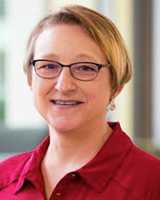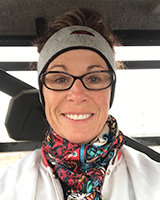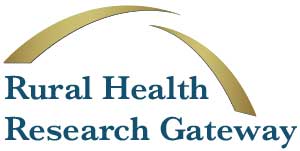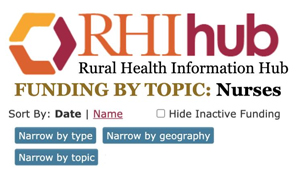Nov 10, 2020
Rural Registered Nurses: Stories of Caring for Their Communities

Rural nursing researcher, instructor, and National Rural Health Association award recipient Jennifer Kowalkowski said the public perception of the nursing profession is important for even student nurses to understand. Reviewing the last Gallup News Service's poll released in January 2020, Kowalkowski pointed out that for the eighteenth consecutive year, the 1,000 survey respondents rated the nursing profession as "high" and "very high" with regard to standards of honesty and ethics, the highest of any profession.
"Particularly in their undergraduate studies, student nurses are often struggling to answer their own personal question, 'What does it mean to become a professional nurse?'" Kowalkowski said. "Advocacy is not quite on their radar yet, but it's one of the most important roles they'll assume. I always tell students to leverage the fact that they are part of the most trusted profession and use the profession's stature to make a difference for their patients and their communities."
Kowalkowski's general comments about the nursing profession certainly apply to rural nurses. However, a more comprehensive understanding of "the rural nurse" can be linked to personal stories: their paths to nursing, their accomplishments, and how they provide for their communities.
Researchers and rural nurses share results and perspectives around being prepared to provide care in rural communities. Read more in Nursing Preparedness: Words from Researchers and Rural Nurses.
From Dreams of EMS to Diploma Nurse to PhD: Dr. Audrey Snyder

Dr. Audrey Snyder's personal story starts with roots in Virginia tobacco farming and moves through her educational degree achievements to her current dual leadership roles: an academic dean — now with a PhD — teaching nursing students and the president of the Rural Nurse Organization (RNO).
"After discovering my gender disallowed EMS as a career path at that time, I had to explore other options for a medical career," she said. "Sixteen miles from my home, I found a hospital-based nursing school with a traditional three-year diploma program. It was the best experience ever. I learned from nurses who'd been in the profession a long time. But when I finished, I wanted to know even more."
Wanting to know more put her on the path to a bachelor of science in nursing (BSN). After her bachelor's came her master's, followed by becoming a nurse practitioner with an interest in trauma. In that role, she worked in urban emergency rooms, but it was her work in rural emergency rooms where she gained appreciation for rural health disparities.
"Though I loved the trauma focus and loved educating my patients, I realized that to change patient outcomes, I needed to teach nurses and do research," Snyder said. "That meant I had to get my doctorate."
Guiding a COVID-19 Student Nurse Experience

Although many academic nurses no longer practice or teach outside their universities, Snyder continues to take students into rural areas. As COVID-19 reached a student-experience location, instead of sending her students home, Snyder put them to work behind the scenes helping to develop policies and procedures for one of Health Wagon's stationary clinics.
"The students learned what screening questions should be asked, what equipment would be required to actually take a testing sample, how to do the sampling, and they helped develop written information for patient distribution," she said. "It ended up being a great opportunity and a great experience for them to develop policies and procedures at the front end of a public health emergency."
Now an
associate dean at the University of North Carolina
Greensboro School of Nursing, Snyder is also president of
RNO, an organization "formed for the purpose of
recognizing, promoting, and maintaining the unique
specialty of rural nursing practice." The
organization has biannual conferences and supports an
open-access publication, the Online
Journal of Rural Nursing and Health Care.
"I think the most important aspect of RNO is that our focus is truly on rural nurses, rural nursing educators, and rural nursing researchers," Snyder said. "We don't have a restriction based on a nursing degree and we even have some members who are not nurses who belong because they are interested in rural health. If there's an interest, we'll find a way to help them contribute."
Snyder said that in January 2019, RNO joined the Council of Public Health Nursing Organizations as the fifth of now 7 organizations that are addressing the issues of current public health disparities. She shared her belief that this membership gives RNO a louder voice.
Understanding RN Credentials and Licensure
Snyder's story is an example of a nursing career that progressed as she received advanced nursing degrees: diploma nurse to PhD. A registered nurse's education is, in part, indicated by credentials. The American Nurses Association provides details of registered nurse degrees:
- Diploma Nursing: hospital-based schools that were once the most common course of study to become an RN. From a previous peak of nearly 1,300 programs, currently around 600 provide RN training, usually within 2 or 3 years.
- Associate Degree in Nursing (ADN): 2-year degree offered by community colleges and some hospital-based schools.
- Bachelor of Science in Nursing (BSN): 4-year degree offered at colleges and universities providing a broader scope of clinical and non-clinical skills. Shorter, accelerated degree programs for candidates holding other degrees are also available, some simultaneously offering master's level training.
- Master's Degree (MSN): advanced study also geared to prepare direct care nurses as well as nurse administrators, nurse educators, and Advanced Practice Nurses.
- Doctoral Degree (PhD or DNP): an advanced doctoral degree where the candidates either focus on research (PhD) or clinical practice (Doctor of Nursing Practice or DNP).
Experts also point out that currently diploma, associate, and bachelor's degree nurses take the same test for certification to become a registered nurse (RN): the NCLEX-RN, or National Council Licensure Examination for Registered Nurses. Though no data on rurality are included, the National Council of the State Boards of Nursing (NCSBN), administrators of the examination, reported that in 2019 nearly 2,000 diploma, 72,000 associate, and 77,000 bachelor's degree candidates took the exam. Pass rates were 88%, 85%, and 91%, respectively.
A Frontier-based Associate Degree Career Path: Julie Russell

No matter what lived experience one has, plans change because, well, life happens — and happens at a pace that influences future lived experiences. Julie Russell's story does not start with a nursing degree, but later getting her associate RN degree has allowed her to give back to communities in frontier areas of Montana in ways she said she never imagined, including attaining another non-nurse health-related licensure. Her path to becoming an RN included many healthcare jobs, many miles — and a few years.
Growing up on a ranch in Powder River County, she first balanced ranch work with work in environmental services at the local nursing home, Powder River Manor. In that position, her patient communication skills were noticed and she said she was encouraged to consider more direct patient care.
"I juggled my ranch work, my job, and my studies for a certified nursing assistant (CNA) license," Russell said. "I loved being a CNA, but I realized that I was still not close enough to the patient care that I wanted to do. I knew I had to become a nurse. Using a grow-your-own approach, the nursing home also gave me a scholarship. So, I went back to juggling a schedule. Ranch work, CNA work, and driving 160 miles round-trip on multiple days per week to the community college that offered an associate nursing degree."
She said she clearly remembers her first day as a registered nurse in a federally funded community health center, now a Federally Qualified Health Center (FQHC.)
"We'd had a patient with a heart attack come in," she said. "As the more senior nurse was assessing the patient, she asked me if I was good at starting IVs. Well, in front of that patient, I couldn't say I'd only done one, so I just answered, 'Yes.'"
Because the patient's condition warranted transfer, Russell said soon the helicopter came. As she looked out to see it land, the sheriff was arriving for traffic control and an Amish woman was running back to protect her pie stand and her children from the chopper blade wake after she'd moved her horse and buggy.
"While we and the transport team loaded the patient, the pilot hopped back into the cockpit putting his pies under his seat — and that was my first official day as a rural registered nurse," Russell said, sharing that she'd been successful with the IV start and that the patient did well and later returned to the community.
Many IVs later, Russell shared that while working at the FQHC, she helped with its diabetic collaborative and also assisted with setting up its telemedicine program, learning how to run the telemedicine equipment — especially important to her because she wanted her community to avoid the inconveniences of long-distance travel. She's visited the Amish community so they too wouldn't have to travel so far with their horses and buggies in order to access care, especially during Montana winters. She obtained a limited permit in radiology to be able to take X-rays in the clinic for the visiting orthopedic physicians so they could better care for patients. She helped with a grant program awarded to the local public health department, acted in a community health nurse capacity, and helped start a school nurse program in collaboration with the local Indian Health Service facility — not to mention working in Chief Nursing Officer (CNO), Director of Nursing (DON), and Chief Operating Officer (COO) positions for skilled nursing facilities and clinics, positions she noted that are not always offered to nurses with associate degrees.
"I love taking care of the patients in my community and making sure we're taking care of the whole patient to understand what non-physical things are impacting their medical conditions," she said. "But I really love teaching others how to provide direct patient care."
Russell's passion for teaching patient care nudged her into creating a hybrid online/classroom CNA course. She now works for Montana Health Network, traveling the state to teach that course and others. She is excited about teaching a new Community Health Worker (CHW) course.
"The CHW model is so important, especially for our state's frontier population," Russell said. "We've just got to get more of these professionals out into our communities where they can help offer home checks on our older population, reach farm and ranch families who can't get to town, and make connections with migrant workers. CHWs can make a huge difference."

Bachelor's-Only Prepared RNs and RN-to-BSN Programs
A 2011 National Academy of Medicine report, The Future of Nursing: Leading Change, Advancing Health, recommended that all nurses have a bachelor's degree and that the number of nurses with a master's degree be increased from 50% to 80% by 2020. Nursing educators emphasized that this call for more nurses with higher academic degrees will only be achievable if more nursing professionals have PhDs to meet instruction needs.
Currently, many rural individuals choose a lower-cost associate degree program. These programs are frequently offered in community colleges and provide clinical experiences very similar to those of bachelor's degree students. Potential strategies for rural RNs to earn a bachelor's degree include the use of career ladder programs and RN-to-BSN programs. Typically university-based though sometimes offered in community colleges, RN-to-BSN programs allow licensed RNs with a diploma or associate degree to obtain their bachelor's degree, building on, rather than repeating, their existing education. Though providing no data on rurality, the American Association of Nursing Colleges (AANC) 2019 position paper on academic progression reported that, as of 2017, enrollment in RN-to-BSN programs has increased by 76% since the 2011 National Academy of Medicine report.
With the call for all nurses to hold bachelor's degrees prompting more RN-to-BSN program enrollment, the University of South Carolina Arnold School of Public Health Rural and Minority Health Research Center queried these programs for presence of a focus that would help enrolled nurses caring for rural populations with their unique health disparities patterns. The researchers' October 2019 policy brief shared their results: of 758 schools, 247 responded and "with a few exceptions, schools of nursing do not conceptualize their students or their educational offerings in a geographic context." Additionally, the results indicated that the majority of RN-to-BSN programs do not offer any rural-specific content.
Looking at the results of another specific research query in order to "distinguish between rural and urban students with regard to potential barriers to program completion," the researchers found that respondents indicated that because advanced degree education was available online, it was equally available in all geographic locations, which, as the researchers pointed out, does not seem to account for potential rural barriers, like broadband access.
Agriculture Health and Safety Educator: Charlotte Halverson

Also a member of the Rural Nurse Organization, Charlotte Halverson has a career story that includes obtaining an RN-to-BSN degree, as well as now leading a scholarship program that includes specific rural content for RNs.
Growing up on a dairy farm 30 miles from Dubuque, Iowa, she originally thought she'd be an English teacher since science and math just didn't seem to be her strong suits. However, she did become a registered nurse and discovered that she loved emergency and trauma care. She said she was ultimately drawn to surgery and post-anesthesia care and worked at a Dubuque hospital that served communities in the tri-state area of Iowa, Illinois, and Wisconsin.
"I liked surgery so much, I saw myself wearing blue scrubs for the rest of my life," Halverson said — joking that she was happy to have found that niche because it also relieved her of shopping for business clothes, an activity she dislikes.
"That was in the late eighties and the farm crisis was just huge big bad news and a lot of nasty things were happening," she said, sharing that she was also completing an RN-to-BSN program. "The healthcare organization we were associated with said that because farmers were such an important part of the community we served, they wanted to do whatever they could to help them."
To meet that commitment, Halverson helped find funding for basic care services like dental care, prescription coverage, eyeglasses, and similar services. She said success with this led to an expansion of the work.
"We discovered that churches were a great place to provide education on rural ag health issues since farm families were all in one place at one time," she said. "So, we started a parish nurse program with about 45 nurses in nine counties. About half of the nurses I managed were in rural communities. What we were able to accomplish with that program started piquing my interest about further program development."
Taking the first agricultural health and safety medicine course at the University of Iowa, she and other nurse attendees from across the state with similar interests in serving their communities decided that, instead of working independently, they should share resources and work collaboratively on program development.
"We started doing clinic services devoted to rural healthcare and suddenly it was a national thing," Halverson said.
The "national thing" Halverson helped create? She said it first started as basic screenings: hearing, lung function, completing a thorough health history, looking at pesticide exposures, and mental health issues. Soon there were more opportunities to provide more information and training on more topics and in different venues to more people. Halverson found herself working with the National Education Center for Agricultural Safety, the National Institute for Occupational Safety and Health, the Progressive Agriculture Foundation, Migrant Clinicians Network, and others.
During the outreach work, Halverson said she began to see benefits and results from educating healthcare providers — in addition to providing direct education and screening for patients. But a dream was to bring this information to rural nurses, who she described as "the actual boots on the ground in the rural communities."
With AgriSafe as lead and with funding support from an agribusiness, Halverson's dream is now a reality: the AgriSafe Nurse Scholar Program. The online, on-demand program covers 15 topics ranging from integration of behavioral health into rural practice, to respiratory diseases, to addressing issues impacting women in agriculture. Leading experts from multiple professions across the nation provide instruction. Continuing education is available for the 18-hour program.
Since the program's start in 2018, Halverson said about 100 nurses from nearly 30 states have completed the program. Currently the program offers slots for 50 scholars per year, with plans to expand further.
From Affordable Associate Degree to Rural Hospital Nursing Leadership and Rural Advocacy: Doctoral Candidate SuLynn Mester
SuLynn Mester's story also includes the initial financial decision to obtain an ADN, and her transition to her current work on her doctoral degree is the result of a well-recognized rural solution: Grow Your Own.
Mester grew up on a cotton-turned-catfish farm in rural Texas. "Nursing something" was second nature to her character, so much so she said she recalls no specific details about her decision to become a nurse.

"Even when I was itty-bitty, from rabbits to racoons, I was always trying to nurse some living thing back to health," Mester said.
Available finances necessitated that she get an associate nursing degree at a nearby community college. With that completed, Mester headed to urban Texas hospitals where she did direct patient care for about 15 years before moving into administrative positions, the last of which was nurse manager of a large heart surgery unit. When her parents became more frail, the urge to get back home to care for them kicked in.
"I desperately wanted to get back to my home area to help care for my parents, but I had to have an income," she said. "The nearby rural hospital was advertising for a CNO. Though I wasn't sure I was qualified with my associate's degree, I applied."
Mester recounted her reaction to that CNO interview: shock.
"For a country girl, I even surprised myself at how little I knew about how a rural hospital really worked," Mester said. "The CEO ticked off the list of hats I'd either be wearing or overseeing, like quality management and staffing grids. Every single question I asked, he said, 'Well, that will fall to you.' I was shocked. I wasn't sure I could do all of that, but I was desperate to be close to my parents."
Twelve years later, Mester said "shock" is just a memory replaced by a leadership reality. In her role as a rural hospital's CNO, she said she works with a terrific nursing staff that's another part of the overall hospital team — a team which Mester describes as a "family" where everyone employed by the hospital is considered part of the team — that provides award-winning care in this 39-bed rural hospital located 120 miles away from the closest tertiary care center. She shared that their hospital is not only a repeat National Rural Health Association award winner, but a Texas Medical Foundation award winner and a recent national emergency nursing award winner.
Because of strong board leadership, Mester pointed out that the hospital regularly engages its community, joining civic groups, giving presentations, holding frequent open-house events, and other public events, like cookouts. Most important, Mester explained, is having their community's representation on hospital teams.
I'm aware that many organizations aren't comfortable with that level of transparency. It makes you very vulnerable, but that vulnerability also opens another door.
"It's important because they bring a whole different perspective," she said. "We think we've got it all figured out and then discover it's not anywhere close to the public's needs. We have them help us work through our processes and problems. I'm aware that many organizations aren't comfortable with that level of transparency. It makes you very vulnerable, but that vulnerability also opens another door: The community sees that transparency as honesty and we find that not only is there a forgiving attitude of 'the past is done,' but an attitude that working together to improve processes for future care is as important to them as it is to us. They help us become the best we can be for our community."
Mester also shared that she believes another board-supported activity is integral to the organization's success: "Homegrown Program."
"Anyone who wants to get more education? The program pays for 100% of their tuition and books," Mester said. "The program just requires that you remain an employee for each year of education supported. There is no restriction on which employees can enter the program. If you're in housekeeping and you decide you want to be a nurse, we support that. It's a tremendously successful program. It makes a huge difference for our recruiting efforts and retention. Our local kids know about this program and tap into it regularly. It's how I've gotten my degrees."
In addition to participating in her organization's Homegrown Program, which allowed her to get her bachelor's and master's and now is allowing her to pursue a doctorate, she's also participated in the Texas Organization of Rural and Community Hospitals (TORCH) Fellowship program, the NRHA Rural Health Fellows program, and the Texas Hospital Association Leadership Fellows program.
"Advocacy wasn't my ball game before I started getting into all these fellowships," she said. "But, understanding and doing advocacy work has been part of the experience. Now I not only have the confidence to do this work myself, but also to push other members of our hospital nursing leadership to get involved at the regional and state level. For example: needs around emergency room and obstetrical care. That advocacy work is not only important for our professional development as nurses, it's important for our rural community."
Additional Resources
 The Rural Health
Research Gateway "provides easy and
timely access to research conducted by the Rural Health
Research Centers, funded by the Federal Office of
Rural Health Policy," including
information on
nursing and nurse practitioner rural healthcare
workforce.
The Rural Health
Research Gateway "provides easy and
timely access to research conducted by the Rural Health
Research Centers, funded by the Federal Office of
Rural Health Policy," including
information on
nursing and nurse practitioner rural healthcare
workforce.
 Many federal, state, philanthropic,
and other sources of financial support are
available specifically for individuals wanting to serve
rural populations or underserved populations in rural
areas as registered nurses.
Many federal, state, philanthropic,
and other sources of financial support are
available specifically for individuals wanting to serve
rural populations or underserved populations in rural
areas as registered nurses.


